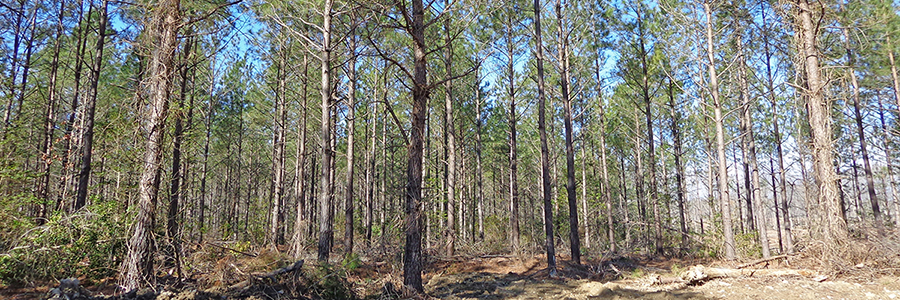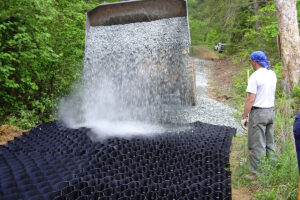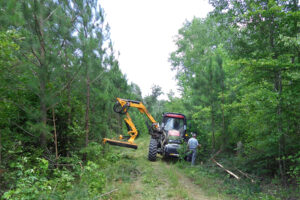
Overview
Dragon Run State Forest occupies 9,563 acres in King and Queen County. This forest of mostly loblolly pine is managed for multiple uses: watershed protection, wildlife habitat, timber production, research, demonstration of sustainable forestry practices, and passive recreation.
More than 9 miles of perennial streams and 18 miles of intermittent streams are found on the property. Nearly 14 acres of frequently changing, open water in beaver ponds are scattered across the property. The Dragon Run Swamp flows 40 miles through the Virginia middle peninsula counties of Essex, King and Queen, Middlesex, and Gloucester. Fed by underground springs, surface runoff, and feeder swamps, it twists and turns, eventually changing from fresh to brackish water as it empties into the Piankatank River. The stream channel and its contiguous swamps are widely known as one of the most pristine bodies of water in Virginia. In fact, a Smithsonian Institute study of 232 rivers and streams in the Chesapeake Bay watershed ranked Dragon Run Swamp second in terms of ecological significance, and number one in Virginia’s part of the Bay watershed.
At a Glance
Access Status: Open to the Public
Hours: Open daily from dawn until dusk
Physical Address:
Latitude/Longitude:
37° 42’ 34.8”, -76° 48’ 26.9”
Parking/Access: Numerous access points from county roads
Limited parking near the gates of forest roads; do not block the gates
Restroom Facilities: None
Visitors are asked to adopt a “leave-no-trace” ethic when visiting the forest, as there are no restrooms or trash cans on the forest itself.
Other Facilities: None
Seasonal Closures: None
VDOF recommends that all forest visitors wear blaze orange or pink during hunting seasons.
The Virginia Department of Forestry acquired the original 1,811 acres of Dragon Run State Forest from The Nature Conservancy (TNC) in 2007, using funds from the Forest Legacy Program. This federal program aims to protect and conserve important forests threatened by conversion to non-forest uses. The main threat to this ecological treasure was the potential for residential development, as urban residents sought to build second homes or retire to waterfront property on the Middle Peninsula.
In 2008, the Virginia General Assembly approved a bond through the Virginia Public Building Authority that enabled the Commonwealth to acquire and/or have conservation easements placed upon large tracts of important conservation lands at key sites across the state. Using these “Conservation Bond” funds in 2009, an additional 7,751 acres was purchased from both TNC and John Hancock Corporation, bringing Dragon Run State Forest to its present 9,563 acres.
In 2010, TNC purchased an additional 13,000 acres from forest industry, then re-sold it to a Timber Investment Management Organization (TIMO), with conservation easements attached to the lands. These easements ensured high standards for forest management and timber harvesting, protection of stream buffers, and reduced potential for future home developments. All told, Virginia Department of Forestry, TNC, Friends of Dragon Run, Middle Peninsula Planning District Commission, Middle Peninsula Chesapeake Bay Public Access Authority, Coastal Zone Management Program, and local county governments have conserved 23% of the Dragon Run watershed. Land conservation along Dragon Run preserves traditional land uses that have endured for at least four centuries. It is also critical to protecting and restoring the Chesapeake Bay downstream.
Approximately 94% of the land is forested with loblolly pine plantations, typical of eastern Virginia forests with a history of forest industry ownership. Management focuses on the demonstration of scientific forest management, applied forest research, development of diverse wildlife habitat, watershed protection, development of diverse timber stands that support biological diversity, and opportunities for passive outdoor recreation.
Recreational uses of the Dragon Run State Forest include hunting, hiking, mountain biking, horseback riding, and wildlife watching.
Visitors are asked to adopt a “leave-no-trace” ethic when visiting the forest, as there are no restrooms or trash cans on the forest itself.
ATV/ORV use, camping, and swimming are prohibited on all State Forests.
A State Forest Use Permit* is required for individuals aged 16 and older to hunt, fish, trap, horseback ride, or mountain bike on state forest lands. The permit can be purchased online or where hunting licenses are sold.
Trails and Roads
- 2.2 miles of forest roads (vehicles allowed)
- 46.4 miles of gated forest roads (no vehicles)
- No driving past forest gates.
- No developed trails on the forest.
Hiking
Hiking is permitted on all forest roads.
Mountain Biking
Mountain biking is permitted on all forest roads.
Horseback Riding
Horseback riding is limited to forest roads.
State law requires that visitors carry a copy of a negative Coggins test report with each horse on state lands.
Fishing and Boating
None
Hunting and Trapping
Hunting and trapping are permitted with a valid State Forest Use Permit and valid hunting license in accordance with state regulations and King and Queen County firearms regulations. Note that some regulations may be different than on private land, so check Virginia Department of Wildlife Resources Hunting Regulations for specific state forest details.
Other Recreational Opportunities
Passive recreational opportunities, such as wildlife watching and nature photography, are available.
- Self-learning opportunities are available.
For more information or questions, e-mail us or use our contact form.
State Forest Main Office
Located at Cumberland State Forest
751 Oak Hill Road, Cumberland, VA 23040-2511
E-mail | (804) 492-4121
Local Contact
Dennis Gaston, Forester
11301 Pocahontas Trail, Providence Forge, VA 23140
Email | (804) 966-2201



